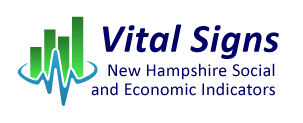New Hampshire’s Planning Regions: Looking Ahead to 2020 (print version ![]() )
)
From the skiing and recreation areas of the North Country to the highly populated southeastern part of the state, New Hampshire is served by nine separate regional planning commissions that assist member communities with issues such as land use planning, transportation planning, environmental issues, housing needs assessments, and master plans.
Every two years, projections of employment by occupations are developed, looking forward ten years. These projections can assist regional planning commissions in allocating resources and helping member communities in making decisions. Like the statewide employment projections, career planners, job seekers, and others can also use this regional data to focus on occupational trends and expected openings.
Statewide, employment is expected to grow by 10.4 percent from 2010 to 2020. Among the planning regions, expected growth ranges from a high of 12.3 percent in the Southern New Hampshire Planning Commission area to 2.5 percent in the North Country Council area.

As with overall New Hampshire employment, more job opportunities in all planning regions are expected to be generated from the need to replace workers that retire or move on to other occupations than from growth and expansion.
Among the nine planning regions, the Southern New Hampshire Planning Commission area is expected to produce the most openings in total, with 1,640 openings from growth and 3,000 from replacement needs. These job opportunities are due to both the large population in the region and growth in industry sectors such as Construction, Professional, technical, and scientific services, and Health care and social assistance.

Differences in projected occupational growth and openings can be explained by the mix of industries and related occupations in each region.
- Regions with a high concentration of employment in Accommodation and food services and Retail trade tend to have a greater percentage of openings from replacement needs. The North Country Council region, with 15.5 percent of total 2010 employment in Accommodation and food services and 16.9 percent in Retail trade, is projected to have 84.5 percent of annual job openings come from replacement needs.
- Regions with a high concentration of employment in faster-growing occupational groups, such as Healthcare practitioners and technical occupations and Computer and mathematical occupations, have a significant portion of projected openings resulting from new job growth. Growth in Healthcare practitioners and technical occupations is led by the Upper Valley/Lake Sunapee area, with 9.3 percent of total 2010 employment. The Nashua Regional Planning area tops growth in Computer and mathematical occupations, with 5.4 percent of total 2010 employment in the region.
- The Southern New Hampshire Planning Region area is expected to have 35.3 percent of openings for all occupations from new job growth, the highest among all regions, while the North Country Council area is expected to have only 15.5 percent of projected openings from new job growth, the lowest share among the planning regions.
Michael Argiropolis
![]() Adobe Acrobat Reader format. You can download a free reader from Adobe.
Adobe Acrobat Reader format. You can download a free reader from Adobe.
Translation Resources and Disclaimer
New Hampshire Employment Security (NHES)
45 South Fruit Street | Concord NH 03301 | 603-224-3311 | 1-800-852-3400
TDD Access: Relay NH 1-800-735-2964





